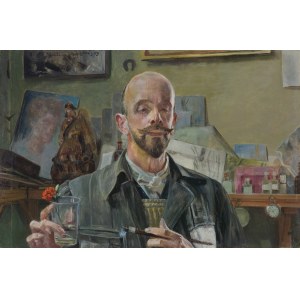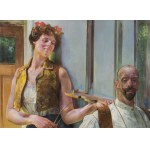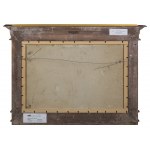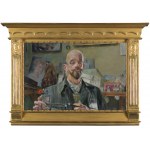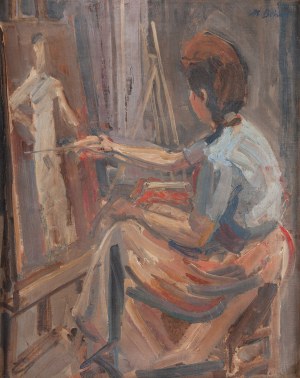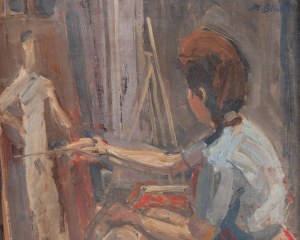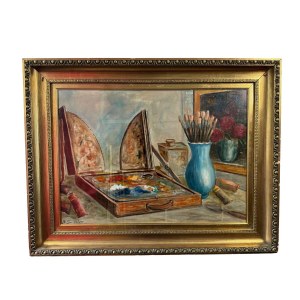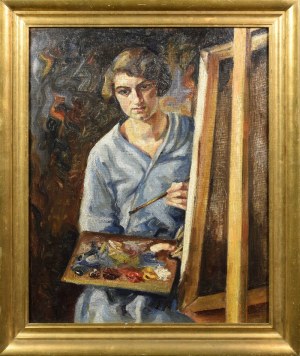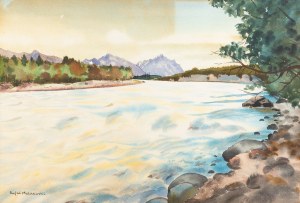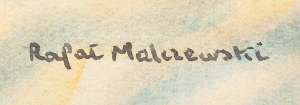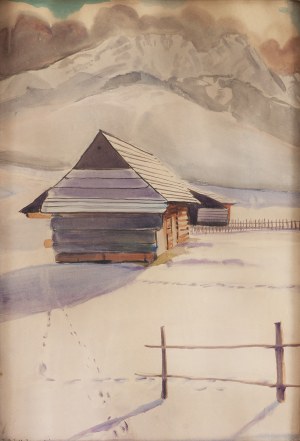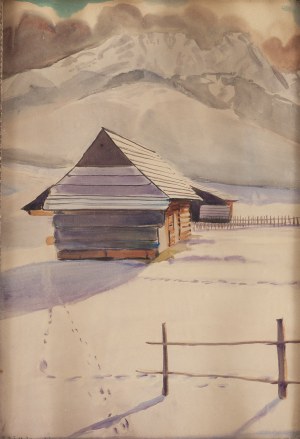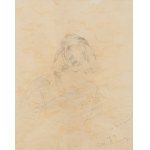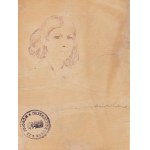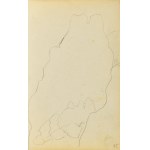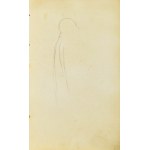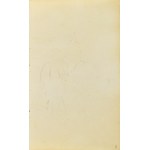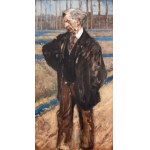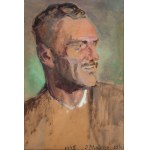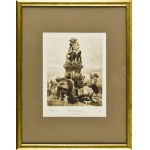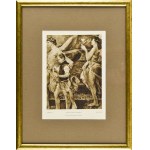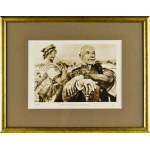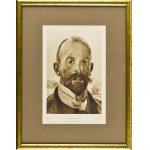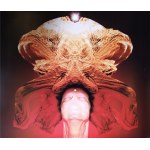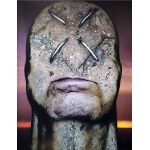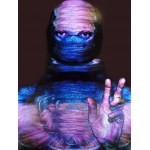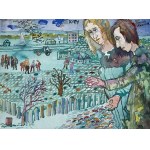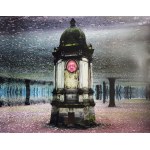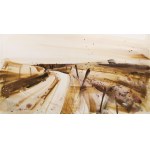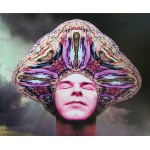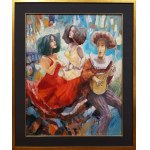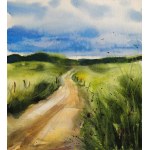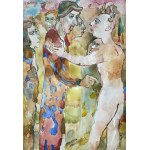40.0 x 59.9cm - oil, cardboard signed l.g.: J Malczewski 1909
On the reverse l.d. stamp with a deer's head; stamp: 23, inscriptions in pencil: [...] | K2- and in the middle: p. Zosia T [...]; also on the frame a sticker of a framing workshop in Ożarów Mazowiecki, and an auction sticker of Agra-Art from 2007.
The painting comes with an expert's report by Agnieszka Ławniczakowa dated July 2007.
The painting exhibited and reproduced:
- Jacek and Rafał Malczewski, scholarly editor Zofia Katarzyna Posiadała, Radom 2014, p. 13, il.
- Godurowska Collection. Polish painting of the 19th and 20th centuries, (substantive concept, introduction, compilation of all works by Tadeusz Matuszczak), Godurowo 2018, p. 49, il.
The artist set the self-portrait in the studio in a real interior - his studio, which was located in the villa "Pod Matką Boską" in Kraków's Zwierzyniec (today 29 Ks. Józefa St.). As Agnieszka Ławniczakowa writes in her expert opinion: This self-portrait, in Malczewski's oeuvre abounding in unusually numerous images of himself, is one of very few depictions showing the artist in his studio. Jacek Malczewski, from around 1900, usually depicted himself in a variety of symbolic contexts that conveyed an in-depth spiritual image of himself and also informed the issues and tasks of his art. Many times in his self-portraits he emphasized his profession through the palette and brush he held in his hands. Sometimes he showed himself in interiors, but rarely - with the exception of his late paintings from the Luslawitz era - in the interior of his own studio.
The work is full of symbols that can be read as a kind of interpretation of the vanitas motif, the passing of time. The painter appeared in bust against a wall with a shelf running across its width. Filled with studio paraphernalia, it is also a carrier of many symbols. Unfinished paintings, flacons with substances needed for mixing dyes and other painting utensils, accompany a damaged wooden statue (presumably St. Michael) and watches hanging on nails. The latter remind us of the inexorable passage of time and the passing of time. The artist is aware of this, which is why he writes his message for future generations under various objects in his works. Vita brevis, ars longa!
In both hands, Malczewski holds references to what he loved most in life - painting and Mary Ball. In his left hand we see a brush applied to his heart. The artist has brought it so close that it has left a blue paint stain on the jacket. In the right hand, meanwhile, the painter gently lifts a glass in which he has placed a red carnation. As a symbol of love, admiration and passion, it refers to a hidden affection. Her sketchy portrait is located just above the flower. Agnieszka Lavniczakova states that: The carnation - as M. Lurker in The Message of Symbols, has been a symbol of betrothal since the 15th century, it also realizes in the paintings of the old masters (in Holbein or Durer) a protective function towards the young couple, while in Eastern culture, it signifies hidden love. And perhaps in the latter sense it was invoked as a meaningful sign in Jacek Malczewski's self-portrait. It is possible, however, that it was also meant to protect that love.
Next to the portrait of his beloved, the artist presents a figure of an angel. It is highly probable that this figure depicts the Archangel Michael. This may be supported by the fact that Jacek Malczewski, like his parents, belonged to the Third Order of St. Francis. As a tertiarist, following the teachings of Francis of Assisi, it may have been to him that he directed his prayers. Indeed, the founder of the Franciscan order believed that it was Michael who presented souls to God, and in him he placed his faith in reaching the Father's house safely. Archangel Michael always fought against sin, not man, which may also have appealed to Malczewski, who with his love for Balowa sinned against his wife, wedded before God. In Malczewski's works, nothing happens by chance, so the placement of the figure right next to the portrait of Balowa cannot be without significance to the meaning of this painting either.
Above the artist's head hangs a horseshoe, which is associated with the legend of St. Dunstan of Canterbury. This patron saint of blacksmiths, locksmiths and musicians, while a monk, engaged in extreme professions. He made objects out of metal, but also played the harp. One day the devil himself asked him to shoe his hooves. The monk, knowing with whom he was dealing, forced him to make a pact. In exchange for the service, the devil was to avoid houses where horseshoes were hung.
Jacek Malczewski was a man full of passion for creation, love and faith. He bequeathed all this to eternal memory in the presented Self-Portrait in the Studio.
Jacek Malczewski (Radom 1854 - Krakow 1929) - a prominent representative of Polish modernism painting, began his artistic studies at the School of Fine Arts in Krakow, where in 1872-1875 he studied under Feliks Szynalewski, Władysław Łuszczkiewicz and Jan Matejko, whose studio he attended again in 1877-1879. He then studied at the Paris École des Beaux Arts under E. Lehmann (1876-1877).
In 1880, he traveled to Italy. In 1884-1885, he took part - as a draughtsman - in Karol Lanckoroński's scientific expedition to Pamphylia and Pisidia in Little Asia. At that time he was also in Greece and Italy. In 1885-1886 he stayed in Munich for several months. Upon his return, he settled permanently in Cracow, from where he made further trips to Munich and Italy. In 1896-1900 he taught at the Cracow School of Fine Arts, and from 1911-1922 he was a professor and twice rector of the Cracow Academy. He spent the years 1914-1915 in Vienna and returned to Krakow in 1916. In the last years of his life he stayed mainly in Luslawice and Charzewice near Zakliczyn. He was a co-founder of the Society of Polish Artists "Art" (1897) and a member of the "Zero" group (1908).
In the early period of his career, he painted portraits, genre scenes and - above all - paintings with themes related to the martyrdom of Poles after the January Uprising (Death of Ellenai, Sunday in the Mine, On the Stage, Christmas Eve in Siberia). Later, from the 1890s, he created paintings with symbolic content with intermingled patriotic, biblical, fairy-tale, literary and allegorical-fantastic themes.
Recently viewed
Please log in to see lots list
Favourites
Please log in to see lots list



